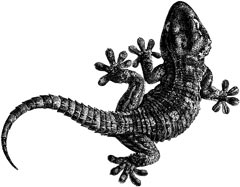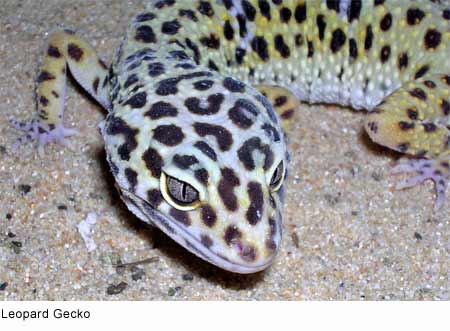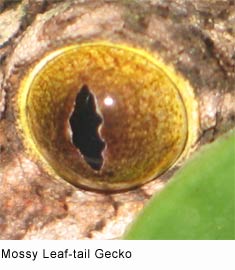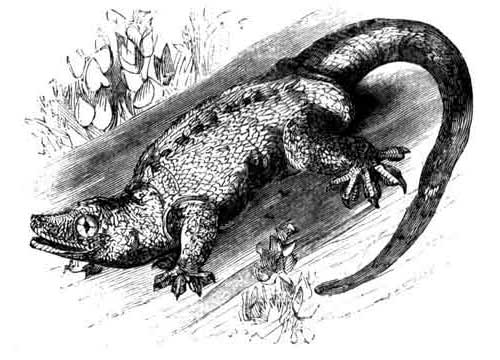|

 Color Profile: Most geckos are tan to dark gray, subtly patterned, and somewhat rubbery looking. Some species can change color to blend in with their surroundings or with temperature differences. However others can be brightly colored. Color Profile: Most geckos are tan to dark gray, subtly patterned, and somewhat rubbery looking. Some species can change color to blend in with their surroundings or with temperature differences. However others can be brightly colored.
Independent Women: Some species are parthenogenic, the females capable of reproducing without copulating
with a male. This improves the geckos' ability to spread to new islands.

Special Toe Pads: Many species of Gecko have specialized toe pads that enable them to climb smooth vertical surfaces and even cross indoor ceilings with ease. These antics are well-known to people who live in warm regions of the world where several species of geckos make their home inside human habitations. These species (for example the House gecko) become part of the indoor menagerie and are seldom really discouraged because they feed on insect pests.
The Leopard gecko (Eublepharis macularius), is a nocturnal ground dwelling gecko commonly found in the desert areas of Pakistan, Northwestern India and Afghanistan.

Can a Gecko Change its Spots? The Leopard gecko gets its common name from the adult coloration of wild specimen, which is generally a cream to yellow ground color with black spots. However, artificial selection in captivity has produced a number of color morphs, distinct from this 'wild-type', possessing many varied colors and patterns.
 Eyelids... on a Gecko? Leopard geckos are one of only a few gecko species (all of them old-world species) that have eyelids. This helps the gecko keep its eyes clean and particle-free in its dusty environment. Most geckos clean and moisten their eyes with their tongues. Eyelids... on a Gecko? Leopard geckos are one of only a few gecko species (all of them old-world species) that have eyelids. This helps the gecko keep its eyes clean and particle-free in its dusty environment. Most geckos clean and moisten their eyes with their tongues.
Another interesting difference in Leopard geckos from most other gecko species is the absence of adhesive toe pads.
Instead, they have small claws. Leopard geckos cannot climb walls or glass, although their claws give extra traction on the ground and are helpful in digging; the same applies for the same group of old world geckos having eyelids. Like all geckos, they shed their tail if chased or grabbed. Although they will eventually grow a new one, the regenerated tail will differ from the original, appearing bulbous and inferior.
In its natural environment, the Leopard gecko lives under rocks or in small caves to avoid temperature extremes. Like many desert dwelling species it is most active at night, hunting insects, spiders, and small rodents as its prey.
Birds and Bees: Leopard geckos are only slightly sexually dimorphic, with the males being somewhat more heavy-bodied than females. Males possess a V-shaped row of enlarged pre-anal pores and a pair of hemipenal swellings at the base of the tail. Females have pre-anal pits and lack paired swelling at the base of the tail. Gender is differentiated during egg incubation and is dependent on the incubation temperature, but gender characteristics are not visible in young geckos.
 All in the Family: The family Gekkonidae is divided into five different subfamilies, containing numerous different genera of gecko species. Many geckos are kept as pets and will eat various kinds of insects and sometimes fruit. All in the Family: The family Gekkonidae is divided into five different subfamilies, containing numerous different genera of gecko species. Many geckos are kept as pets and will eat various kinds of insects and sometimes fruit.

Some common gecko species are:
Crested Gecko, Rhacodactylus ciliatus — Until recently believed extinct. Gaining in popularity as a pet.
Crocodile or Moorish gecko, Tarentola mauritanica — Crocodile geckos are very strong and heavily built for their size usually growing up to 15.24 cm (6 in). They are commonly found in the Mediterranean region from southern France to Greece and northern Africa. Their most distinguishing characteristic is their pointed head and spiked skin with their tail resembling that of a crocodile's.
Gargoyle Gecko, Rhacodactylus auriculatus — commonly known as the New Caledonian bumpy gecko or Gargoyle gecko.
Golden gecko, Gekko ulikovski — native to the warm rainforests of Vietnam.
House gecko, Hemidactylus frenatus — A species that thrives around man and human habitation structures in the tropics and subtropics world wide.
Indo-Pacific gecko, Hemidactylus garnoti — Also known as a fox gecko because of its long, narrow snout. This species is found in houses throughout the tropics. This gecko may eat leafcutter ants.
Leachianus Giant Gecko, Rhacodactylus leachianus — first described by Cuvier in 1829, is the largest of the Rhacodactylus geckos.
Leopard gecko, Eublepharis macularius — The most common gecko kept as a pet is the leopard gecko, which does not have toe pads with setae, but rather claws. These enable it to more easily climb on rough surfaces like tree bark. This gecko cannot climb the glass of a terrarium. The leopard gecko tends to be docile and calm. This gecko can eat cockroaches, crickets, mealworms, waxworms, and superworms.
Mediterranean gecko, Hemidactylus turcicus — residential and wild, introduced species (USA).
Mourning gecko, Lepidodactylus lugubris — This species is equally at home in the wild as in residential neighborhoods. Found in Hawaii, it may have been an early Polynesian introduction. A parthenogenic species.
Stump-toed gecko, Gehyra mutilata — This gecko can vary its color from very light to very dark to blend into a background. At home in the wild as well as in residential neighborhoods.
Tree gecko, Hemiphyllodactylus typus — Tree geckos are forest dwellers.
Tokay Gecko, Gekko Gecko — a large, common, Southeast Asian gecko known for it's aggressive temperament, loud mating calls, and bright markings.
All text is available under the terms
of the GNU Free Documentation License |